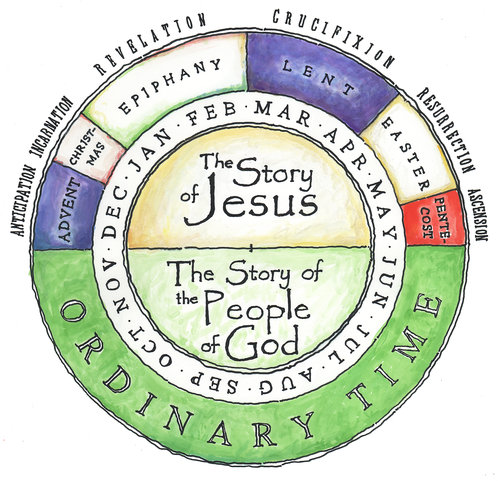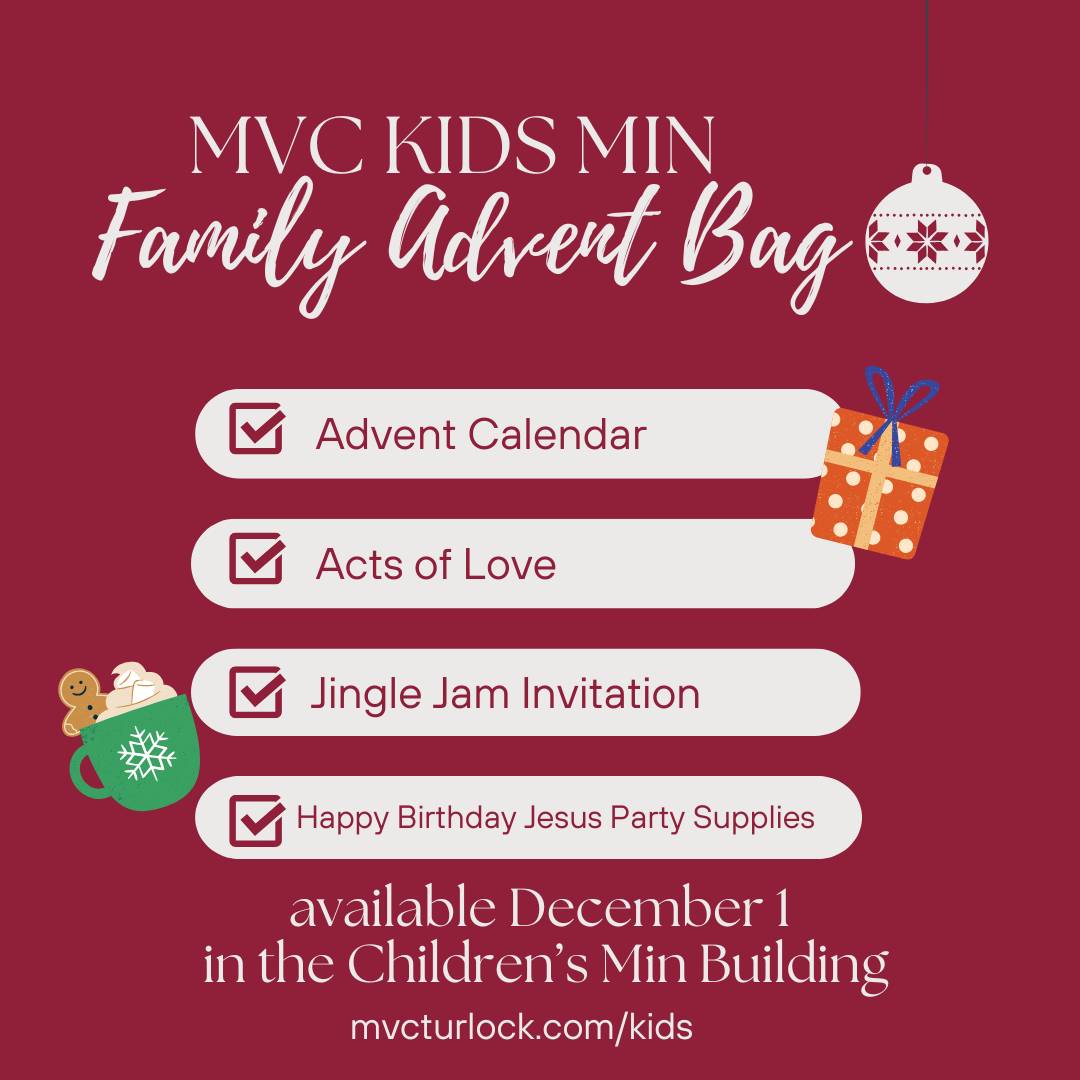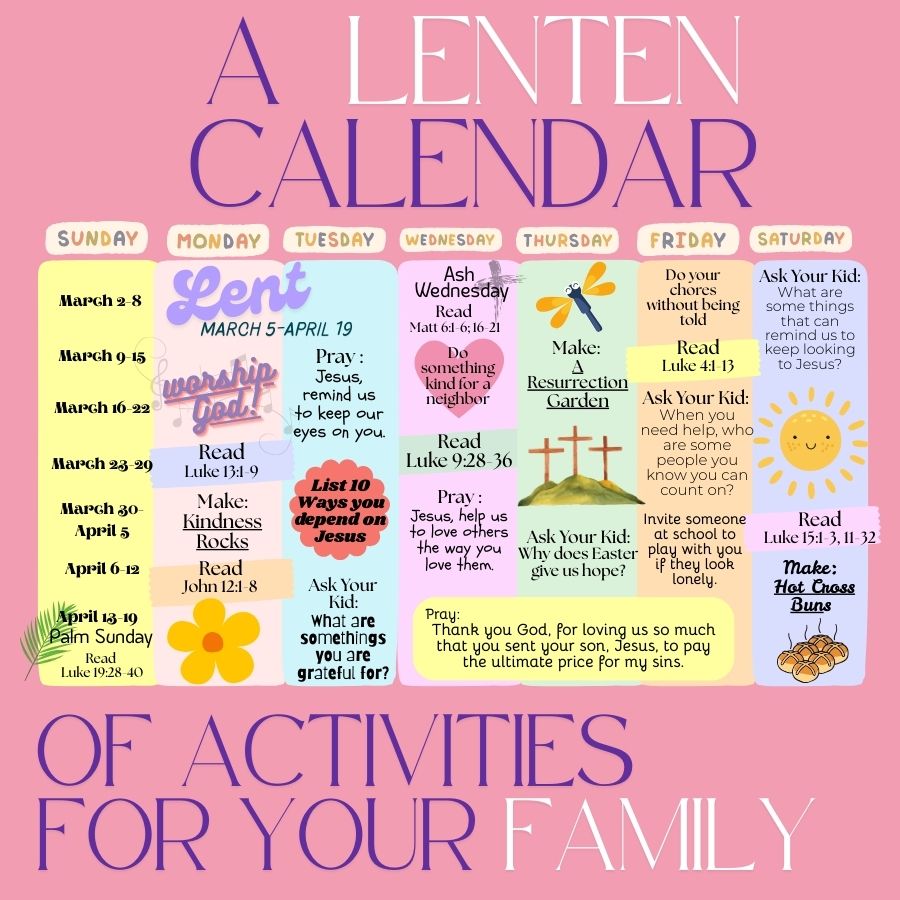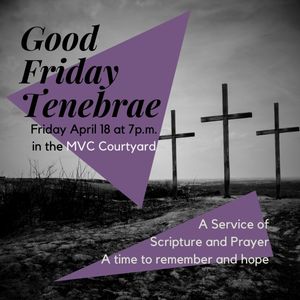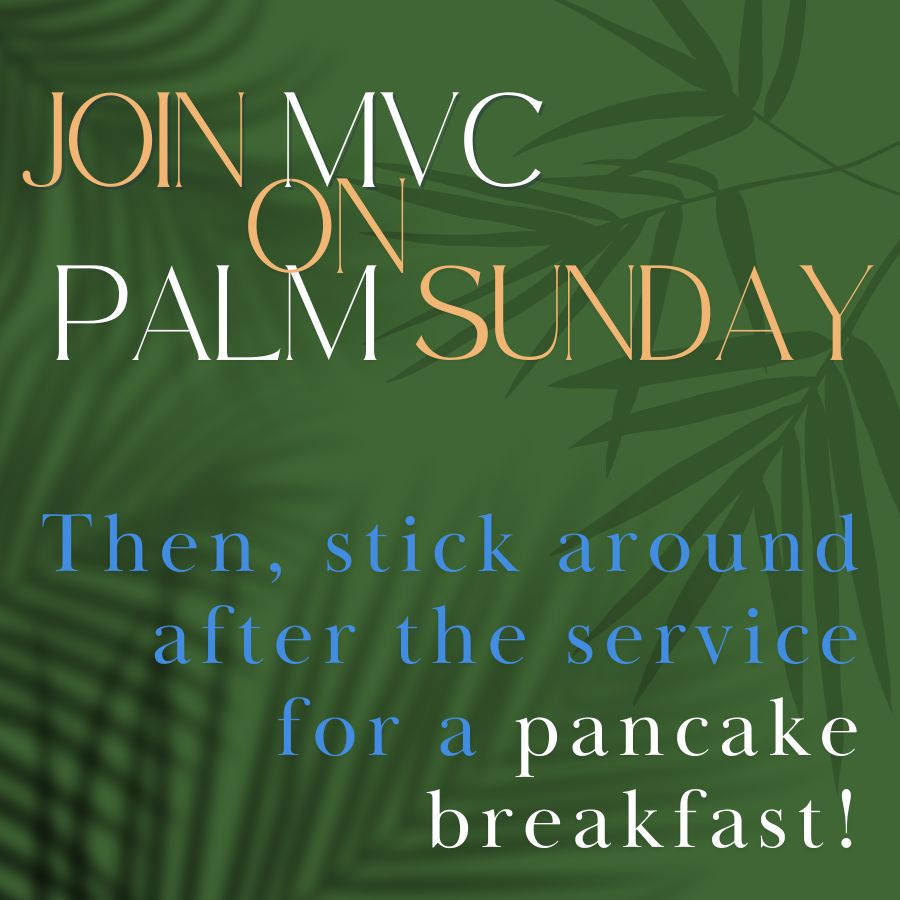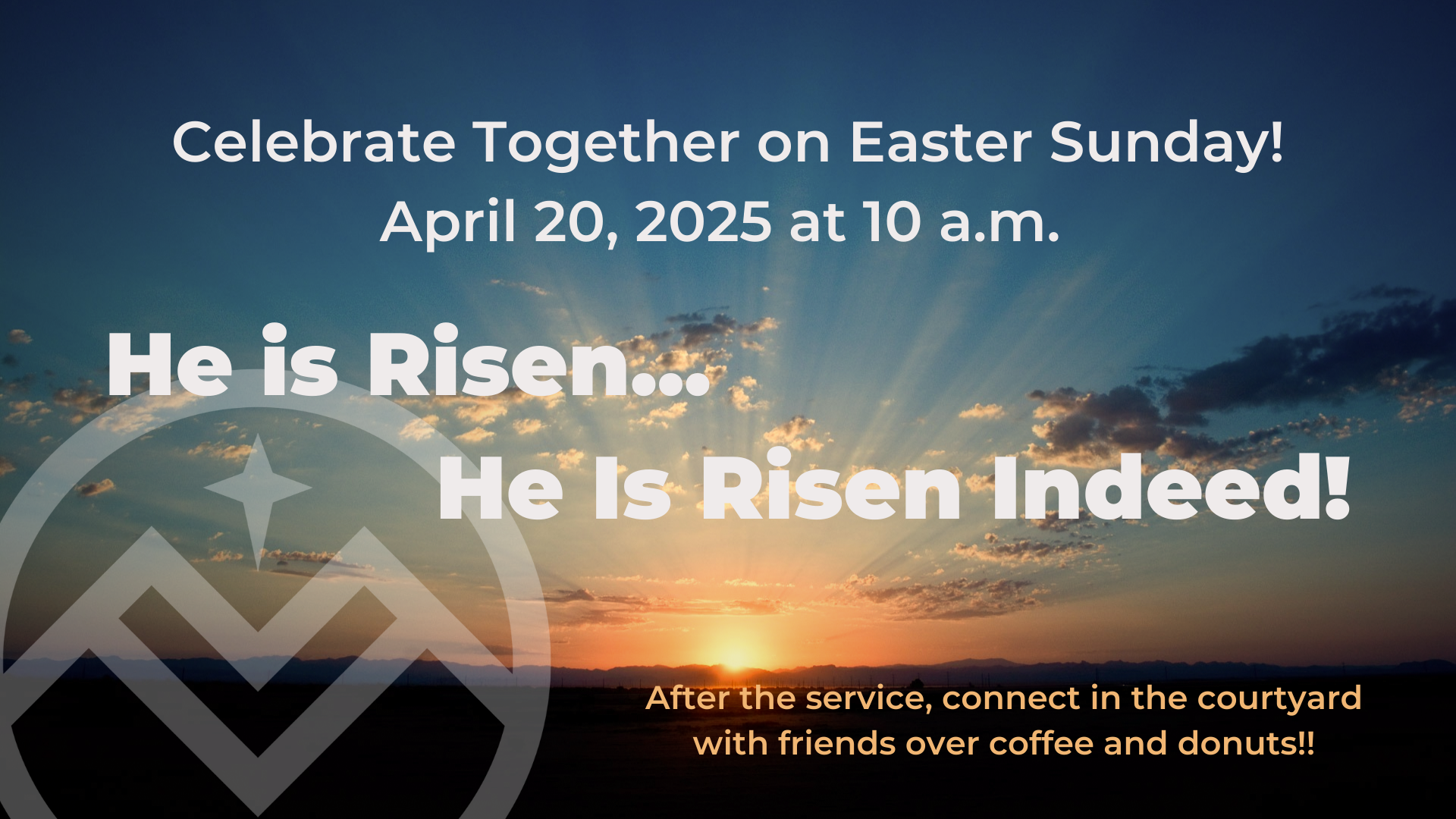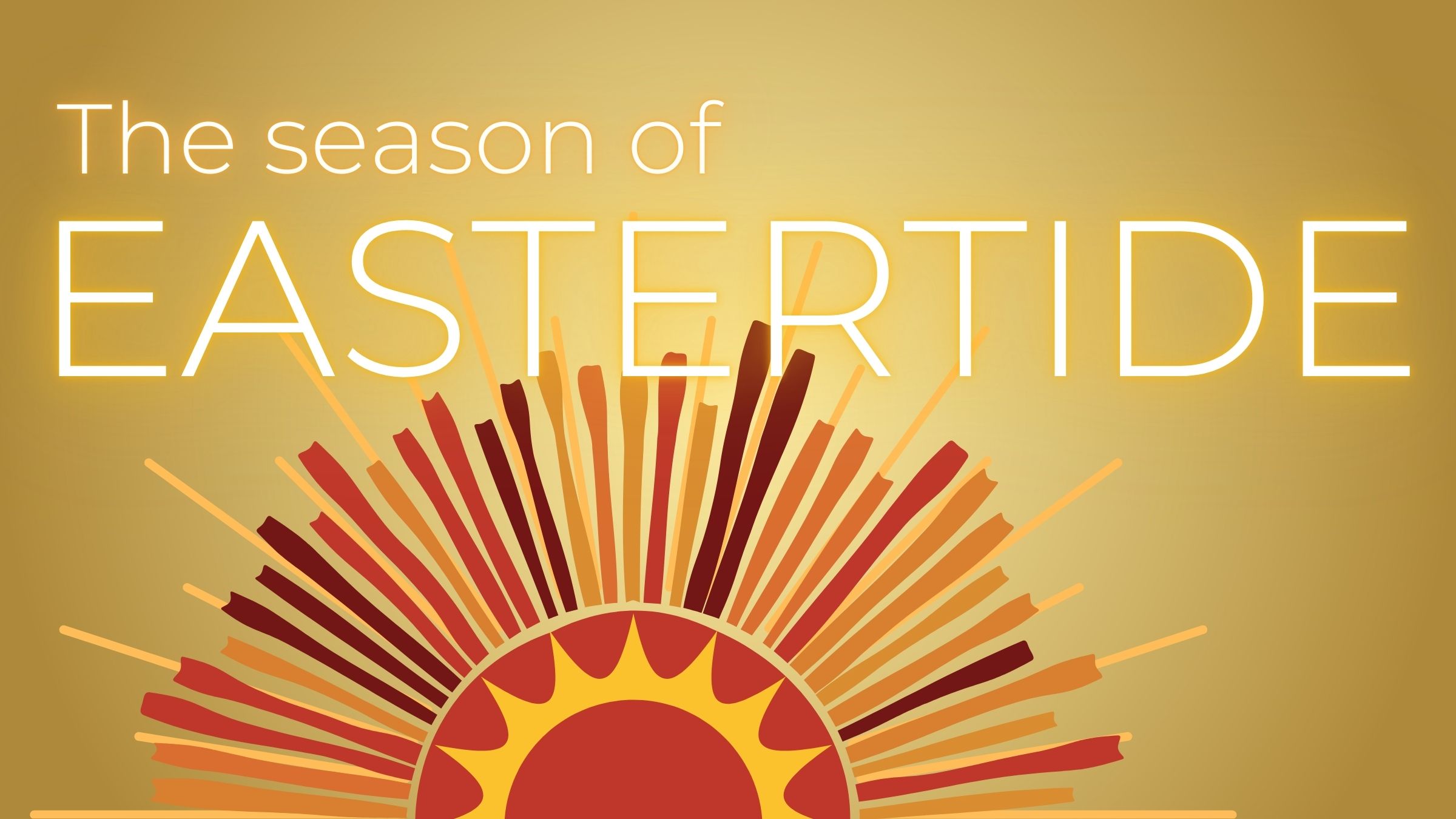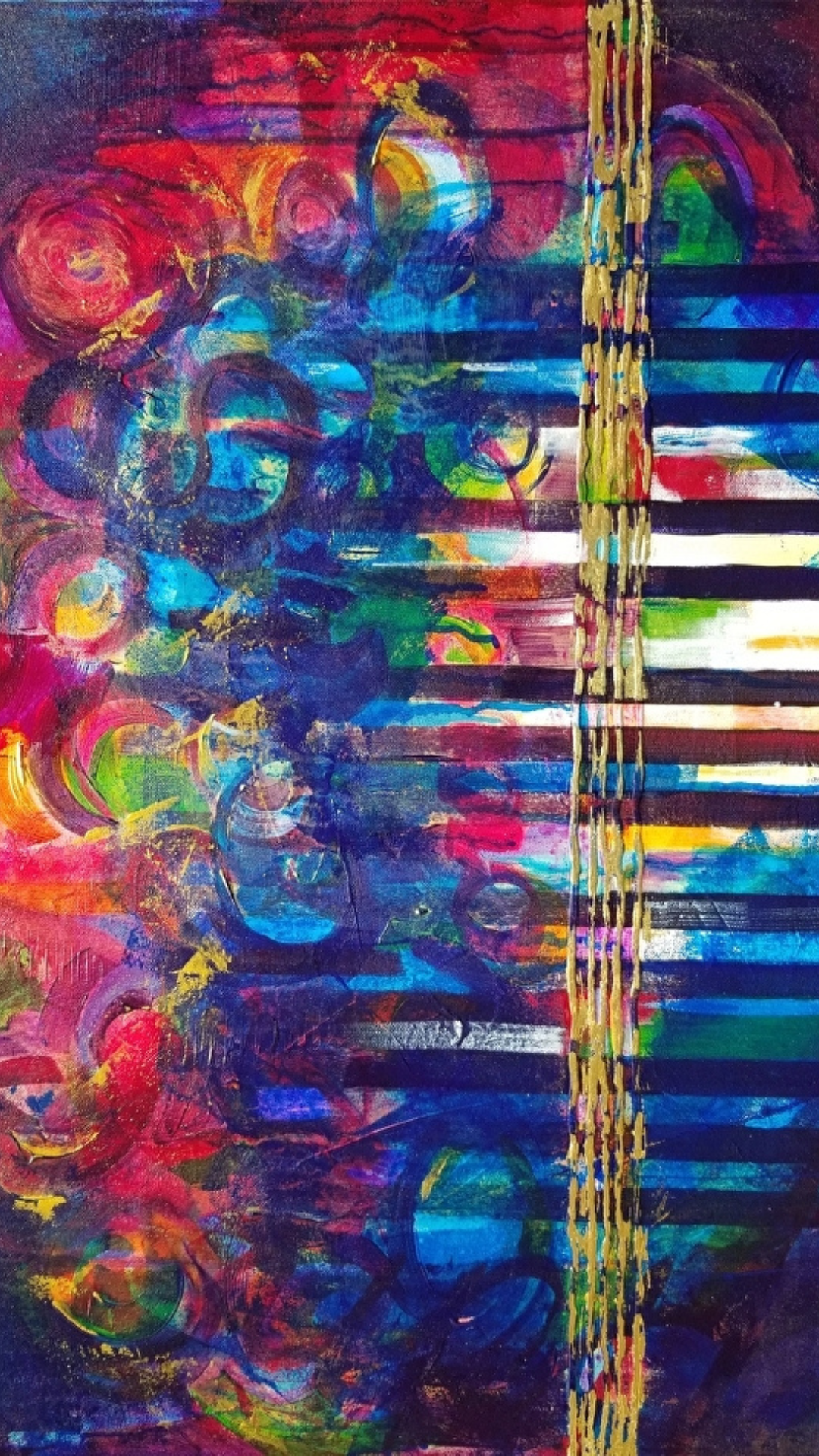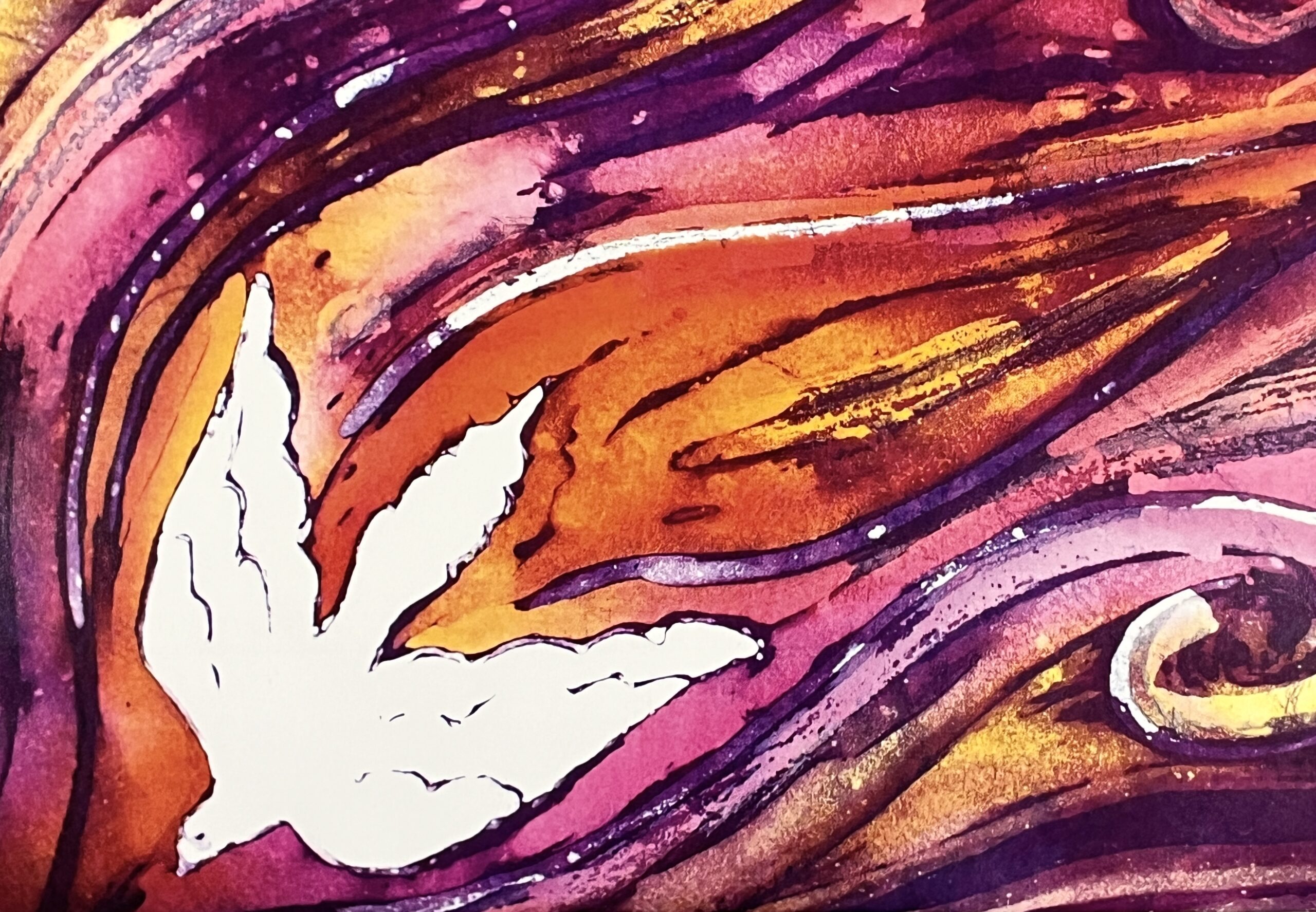THE STORY OF JESUS
Experiencing God through the Seasons of the ChurchScroll or click to a season of the Church
| ADVENT | CHRISTMASTIDE | EPIPHANY | LENT | HOLY WEEK | EASTER | EASTERTIDE | PENTECOST |
ADVENT – our season of preparation
As Thanksgiving wraps up, we turn the corner to Advent, which begins this Sunday, December 1! For those of you who are unfamiliar with the church calendar, Advent begins the church year with the first chapter in the story of Jesus. It lasts four weeks and ends on Christmas day. The word ‘Advent’ comes from the Latin word ‘adventus’ which means ‘coming’ or ‘arrival’. Used by the church, Advent refers to the first arrival of Jesus, when he was born in Bethlehem. Advent also anticipates the second coming of Jesus, where all things will be made right as he ushers in a new heaven and a new earth.
With these two arrivals of Jesus as our focus, Advent is a season filled with expectation. An Advent wreath with colored candles will once again be on display in the Worship Center to represent each of the Advent themes (hope, peace, joy and love), with a fifth candle in the center to represent the birth of Christ. Another thing you will notice is the presence of the color purple. It is the color of royalty which points us to the coming of King Jesus!
Our invitation to you during Advent is to intentionally make room to reflect on this first chapter of the story of Jesus. Make a commitment to attend Sunday services during this season as we remember how our smaller stories are all parts of God’s greater story. Purchase a ‘Seasons Calendar’ at church which contains the scripture passages we will be using during our Sunday services for the first half of the year. Consider using the family Advent calendar provided to you by our Children’s ministry as a way to help your whole family anticipate the birth of Christ. Make the coming of Jesus the centerpiece of this season and notice all the ways you are awakened to his presence in your life.
This year, Casey Giffen, our resident poet and creative writer, will share his reflection on each of the pieces of art that are found in the Seasons Calendar. We hope these reflections will help you engage both the paintings and the season they represent.
Along with the blessed, familiar story of the Mother of God, “The New Eve” illustrates something new for all of us. The lowliness Mary experiences sets free our souls like her pocketed, shattered chains symbolizing victory over death. Mary did not desire “…all generations to call me blessed…” That longing leads to self-aggrandizement. The promise—chosen by God to be the Mother of Immanuel—is a natural-birthing of Christ, just like the promise to the first Eve in Genesis: the certainty that humanity’s heels would be sorely struck; however, the serpent’s head hammered and defeated, symbolized by the snakeskin in her pocket.
Mary’s motive for proclaiming, “My soul magnifies the Lord, and my spirit rejoices in God my Savior…” manifests majestically because God looks with favor on her. Prior to the Annunciation, Mary is intentional in perceiving where to discover her longings. She steers clear of contrived lowliness and runs straight into divine love.
In his book Soulful Spirituality, David Benner paraphrases Plato to explain that our desires and longings are more persistent and larger than our satisfactions: “We are fired into life with a madness that comes from the gods and which would have us believe that we can have a great love, perpetuate our seed, and contemplate the divine.” Mary’s madness allows her to rest as she propels her soul to hunger, to seek, to dream, and to long for God. She avoids the temptation to settle for simple satisfaction and addresses her desires and longings.
I wonder if I can give myself the grace to be curious, to be seeking, and to be open to perceiving Immanuel anew this Advent season. To long for him. To desire more of him. Today, as with Mary, Immanuel is with us, and he longs for us to long for him.
There are many opportunities for the whole family to come together during the Advent season at Monte Vista Chapel!
Get the songbook, CLICK RIGHT HERE!
Click the icon for full screen to sing along or lead a group in your very own neighborhood!
Come Together Tuesday December 24th at 4:30 pm.
A Christmas Eve service for the whole family.
A Daily Advent Reading Plan for your Family!

“On the first day of Christmas my true love gave to me…” Most of us are familiar with the first line of The Twelve Days of Christmas, but did you know that for almost 1500 years, much of the church actually celebrated Christmas for twelve whole days. Beginning in 567 A.D., the church formally set aside the twelve days from Christmas to Epiphany (stay tuned for more information about Epiphany in a few weeks) as a prolonged celebration of the birth of Jesus. This tradition continued through the middle ages and into the modern era. However, for many in the American Church, Christmastide has all but faded away in a blur of post-Christmas shopping, gift returning, and resolution planning.
So then, what IS Christmastide? Great question! Christmastide is the 12 days of celebration that begins midnight on Christmas Eve, which is the beginning of the first day of Christmas. Then, the second day of Christmas is December 26, the third day, December 27, and so on, until all twelve days of Christmas have passed. Some traditions have specific celebrations on the various days of Christmastide, but the main purpose is to prevent the world-altering incarnation of Jesus from being a ‘one-and-done’ holiday. Truth is, something as amazing as God becoming flesh shouldn’t be rushed. Rather it should be savored and celebrated over a long period of time.
So let’s do just that. Let’s not be done with the incarnation on December 26th. Instead, let’s slow down and marinate in God’s amazing expression of love. Consider keeping your Christmas decorations up for the twelve days of Christmas… or at least some of them! Remind yourself that generosity doesn’t stop at 11:59pm on Christmas night by giving gifts or doing acts of kindness throughout the twelve days of Christmas. Instead of thinking the holiday is over when you return to work or school, develop an ‘incarnational mindset’ in which you remember that your vocation is to bring Jesus into your world in all you do and say.
This year, let’s allow the twelve days of Christmas to hold us in the place of both receiving and giving the overwhelming gift of God’s love.
The 12 Days Of Christmas

“Unto Us A Child Is Born” by Bailey Hindmarsh.
The beauty and wisdom of iconography is that we can see old, familiar events in a new, restorative way. We are invited to contemplate the manger tableau in Bailey Hindmarsh’s Unto Us a Child is Born with wonder and with curiosity. Ironically, in Hindmarsh’s mini manger menagerie, the scene features paradoxical animals watching over the Babe, underscoring Isaiah’s prophesy. The absence of the traditional iconography of the Mother of God and Joseph with their child ignites our curiosity, imagining them on the periphery.
I wonder if this linocut print invites us to consider what kind of animal we might be and how we might behave. For instance, as a leopard, we sometimes change our spots depending on sticky situations, or we morph into timorous little lambs, uncertain whether or not to trust God. Other times, we act like a cowardly lion when living life on our terms, or we yearn for a life of ease like a foolish yearling wanting to nuzzle road apples and eat them, too.
Whatever the paradoxical animal we might experience at times—good, bad, or indifferent—one relationship impacts how we see God; sometimes the way we interact with God is contingent on the effects our fathers have had on us.
I wonder which, if any, of the following statements represent how you would announce the Son-providing God of the Bible: 1) God sent his son; 2) The Father sent his son; or 3) Abba—the Arabic word translated as Daddy—sent his son. Perhaps, these three demarcations differ for some readers depending on individual life experiences. For example, my father died of cancer when I was 16. My relationship with him was loving and nurturing in spite of family dysfunctions. He was not a hugger or a mess-up-my-hair kind of dad. Just 16, I was beginning to develop my personal values and adult decision-making ventures without the locking-horns angst toward parental authority. Conversely, my older brothers, who grew up in the 60s but didn’t remember it, fought with him. One particular day, when I was ten, I stood at the doorway, hearing my 16 year-old brother and Dad arguing in the house, wrestling and grunting, and then my brother running away, yelling.
As for biblical Old Testament stories, many fathers betray, belittle, and abandon their children: Isaac plays favorites (Genesis 25:28); passive David is nonplussed with his sons (II Samuel); and Mannasseh sacrifices his children (II Chronicles 33:1-6) to name a few. The Old Testament identifies God as Father 15 times. Besides his holiness, perhaps the noticeable omittance of identifying God as Father is partly due to poor examples of human fathers.
On the other hand, in the first four books of the New Testament, Jesus references God as Father over 165 times. Jesus, who arrives in a manger, grows to be the fulfilling-prophet Son of God, and announces truly good news: to whatever degree we have interacted with earthly fathers, we can vulnerably connect with our heavenly Abba…our Daddy. This is the cozy, compassionate Abba who “kisses each star,” longing to embrace us and kiss us; Abba who’s “thrilled to adopt the pulsar beat” and hold us close to his heart like John the Beloved resting on Jesus’ bosom; Abba who, because of the Son saying yes to everything his Abba asks, is “new-birthing us into fellowship” right now.
Imagine encouraging those you know and those you meet for the first time during these 12 days of Christmas, that they, like you and I, can know God as Abba intimately like he desires us to experience him. Jesus ushers into humanity a divinely deep relationship with Abba. This is gospel; this is good news.
New-birthing Us
A stable father sees his serene son
sleeping, starry-straw embracing him,
like a million galaxies one-by-one
smiling eternally, never growing dim.
Heavenly Abba kisses each star
thrilled to adopt the pulsar beat,
as Milky Way reads a heavenly memoir
narrating novae redemptive feat
So that kingdoms can come together fast—
the one way high in glorious heaven
then on earth with us, Peace-Prince at last
for that good, and just, and loving succession—
Our offspring spying who’s lying in the manger
relays unabashedly the greatest gospel news to say:
stable parents then saw their some-day Easter Son,
new-birthing us into fellowship with Abba today.
-Casey Giffen
Every year, on January 6, the church remembers and celebrates the day when the Magi (wise men) visited Jesus. Depending on the tradition, Epiphanytide, or the Season After Epiphany continues forty days from Christmas and ends when Jesus was presented at the temple (according to Leviticus 12:1–8, Mary would have to be ritually purified after childbirth), or it continues until Ash Wednesday, which is the beginning of Lent. (More on this in a future email) We will observe the latter.
The word epiphany comes from the Greek word epiphaneia, meaning ‘manifestation’ or ‘appearance’. For this reason, the Season after Epiphany focuses on the ‘appearances’ or ‘manifestations’ of Jesus not only to the Jews, but the Gentiles as well. As such, it makes perfect sense that this season begins with the visit of the Magi, as they were most certainly Gentiles. In addition to the coming of the Magi, the baptism of Jesus and the miracle where Jesus turned water into wine at the wedding in Cana are also commonly associated with the Season after Epiphany, as they are two more central events in Jesus’ life where he ‘manifested’ or revealed who he was to the world. The biblical texts of these three events are often used in the Season after Epiphany.
This particular season of the church calendar is one that resonates with Monte Vista’s heart for world missions, as Epiphany reminds us that the mission of the church is to reach all nations with the gospel. As we enter this season, may the following prayer guide us:
Lord of all Nations
We longed to see your face, to hear your voice
Best sa we could, we kept the faith, and reached out in prayer
But too often, we failed to find you
And then one day, you placed yourself within reach
In the person of a child as vulnerable as any of us,
King and peasant beheld you –
Man and woman, slave and free, Jew and gentile
For you had come for all
‘Epiphany’ we call it
Manifestation… Appearance
The Word made flesh
We have since known other Epiphanies
We have been filled by your Spirit
We have met you in the faces of our brothers
The graces of our sisters
The hand that reaches out
The heart that weeps for others
In the strength of one who protects
In the gentleness of one who forgives
We have seen your face
We have heard your voice.
As broken as we are
As scared and uncertain as at times we may be
May others see something of you in us
May they hear the sound of your voice
May you be revealed through us to all peoples
May epiphanies abound
Be born in us, O Lord.
Resettle Us
by Casey Giffen
Resettle us Adoni
as only you can do,
like winter waiting with calm
for spring, anticipating when
all things bud anew.
Resettle us Holy Spirit
as our hearts beat with hope,
like salmon swimming upstream
for a purposeful, selfless destination
where pooled faith helps them cope.
Resettle us loving Abba
as our dusty humanity forms,
like roots searching for sustenance
with the lightness of your spirit
sprouting heavenward from earthly storms.
By resettling in your company
you let us see you, our Epiphany.
This Season’s art piece is Maureen Steward’s “Star of Wonder”
Star of Wonder
An Epiphany Reflection
As you view Maureen Steward’s Star of Wonder, imagine being one of the three wise men standing in awe at the star of Bethlehem. The star has stopped. Beams of starlight reveal, reflect, and reinforce the ultimate reality of the incarnate Christ, your Messiah in flesh. Joy overwhelms you.
This is Epiphany.
Consider what leads to this Epiphany. The wise men, also known as kings or Magi, had settled themselves in a receptive position long before setting out on their journey from the east. They learned to discern. That discernment resettles when the Magi avail themselves to trusting a mysterious dream and opting to travel back to their country by an alternate route rather than returning to the nefarious Herod determined to kill the Christ.
At Monte Vista Chapel, formational conversations are encouraged in order to resettle us: we experience Abba’s love by observing what’s happening in our lives, we listen to the Holy Spirit’s invitation, and we cooperate intentionally as we journey with Jesus. This what-would-Jesus-do-if-he-
Discernment, wisdom, epiphany…these are mysterious concepts, divine descriptors which humble us while any possible pride evaporates. If we tend to look for a self-imposed, epiphanic discovery—one where we are not comfortable with mystery but prefer knowing answers thus eliminating Trinitarian mysteries—we might undergo a season just like any other season. Perhaps Thomas Moore received an epiphany when he stated, “At best we can never be more than approximately correct when we speak about spiritual matters. The part that remains unknown and unspoken gives our words and ideas the emptiness they require.” This season of Epiphany provides a paradoxically “purposeful, selfless destination” where we die to our ways of searching for an epiphany yet live with our sitting in overwhelming joy. Set aside a sacred space for “emptiness” this season so that the Trinity can interact with you, fulfilling your longing to become and to do.
Our Second Epiphany art piece is Cindy Mackenna’s “Water Into Wine“
Water Into Wine
An Epiphany Reflection
Cindy MeKenna’s acrylic on canvas Water into Wine illustrates a “…contemporary depiction of the first miracle of Jesus…” The calendar comment provides a beautiful reminder: “Trusting in Jesus, we are assured that the abundant life God intends for all is full of the splendor of God’s glory.”
The inspiration for The Satisfying Wonder of Water is soaked with God’s glory. I wonder if some of the same H2O molecules morphed throughout the Old Testament into the New Testament. Parting the Red Sea. Flowing water from a rock. Dousing water on a fiery alter. These are astonishing interactions.
Then we read of Jesus’ first miracle in John 2:1-11. Enter Jesus. A wedding ceremony. Six stone water jars. Imagine the uber-satisfaction on the face of the banquet master, on the face of the bridegroom. Talk about an epiphany! What happens? “He (Jesus) thus revealed his glory, and his disciples put their faith in him.” The Trinity perpetuates glory. The disciples put faith and trust into their Rabbi. All from the rearranging of a few molecules.
Last month, folks who call Monte Vista Chapel home pondered the beginning of Epiphany: “…that Christ Jesus manifests God. Jesus is the One to follow. We sit at his feet in this season, learning again what we are called to be and to do.” The “to be” is glorious. All of humanity, each individual body composed of roughly 60 percent water, we are created in God’s glorious image. The “do” part is divine, too. Like the twelve disciple who trust their Rabbi—a soul-satisfying relationship much more significant than a creed, tenet, or doctrine—we are called to do the discipleship marriage dance. We two-step in step with the Trinity as we go and make disciples. We tango with those in the name of the glorious Father, Son, and Holy Spirit. We foxtrot to teach what Jesus commands, especially as coined by Dallas Willard in the Discourse on the Hill commands. The organic “miracle” of conversion ensues, just as miraculously as water into wine, but not based on our “to do.” The miracle of inner transformation takes place on a divine dance floor where the Trinity is in step with the soon-to-be-convert disciple. It’s a waltz with the Trinity serenaded by a this-is-my-beloved love song. For the satisfying soul we long for/ is the Vine where wine will pour.
The Satisfying Wonder of Water
by Casey Giffen
Were we a body of water
without our body to welcome
the Yam Suph1 parting, we’d be
satisfying.
Were we a water-rock
wanting to be spoken to
rather than struck twice, we’d be
satisfying.
\Were we to sacrifice our watery
selves on alter fire, pooling
within the abundant Truth, we’d be
satisfying.
Were we that initial water miracle
where wine ensued without fermenting
for the natural time, we’d be
satisfying.
For the satisfying soul we long for
is the Vine where wine will pour.
The Red Sea
The church calendar revolves around the two most impactful events of Christ’s life; his birth (Christmas) and his resurrection (Easter). Both of these events are preceded by seasons of preparation. Advent prepares us for Christ’s coming, and Lent prepares us for Christ’s death and resurrection. Lent begins on Ash Wednesday (March 5 at 6pm) and continues for 40 days, not counting Sundays, and concludes the day before Easter.
The most common and well known practice of the Lenten season is fasting. Reflecting Jesus’ forty day fast in the wilderness, Lent’s forty days of fasting invites us to open our hearts and minds to notice the things we have put before or between our relationship with Jesus. Then, with humility and courage, we intentionally set those things aside and renew our focus on Jesus as our source of life. This year, Monte Vista has also chosen to fast from the Lord’s Supper (communion) during Lent. The hope in stepping away from this reminder of God’s greatest gift is to help us not take Christ’s sacrifice for granted and to appreciate it in a new way when we participate in the Lord’s Supper again on Maundy Thursday. (The day Jesus first celebrated the Lord’s Supper with his disciples in the upper room.)
Historically, fasting has focused on abstaining from food, but over time, the Lenten fast has come to include anything from sweets or alcohol to social media or television. Whatever is chosen, the point of fasting is to redirect our focus to God. When our impulse is to grab a sweet snack or scroll through social media, fasting invites us to redirect our attention to the only One who can truly satisfy our longings.
Being that we are following the church calendar, we will host an Ash Wednesday Service to mark the beginning of Lent. After a brief reflection on the goodness of God and our ongoing need for repentance, the service will conclude with ‘the imposition of ashes.’ This is a time for those who have committed to the coming forty days of fasting to have their foreheads marked with ashes in the shape of a cross. It is important to note that while this practice is new to many of us, it is meant to reflect a practice from scripture. Throughout the Old Testament, a devoted Israelite would cover themselves in ashes as a sign of their grief and sorrow. In a similar, but less dramatic fashion, the ashes on our foreheads serve as a symbol of our grief and sorrow for allowing other things to come before our devotion to God.
While Lent and Ash Wednesday are fairly new to many of us at Monte Vista Chapel, devoted Christians from around the world have found this season to be deeply spiritual as they reorient their lives around God and his redemptive plan for the world. If you would like to join in this tradition, we ask you to consider how, and what God is inviting you to fast from during the forty days of Lent. You are then welcome to join others from the community to mark your commitment at the Ash Wednesday service. Finally, remember that Jesus, through his Spirit, is walking with you during your forty days of fasting. He knows what it is to be tempted, and he will gladly give you the grace you need to trust in your heavenly Father to meet your deepest needs.
Gethsemane – mixed media/photograph by Lin Eizabeth Priss
Gethsemane
A Lent Reflection
In Lin Eizabeth Priss’ mixed media/photograph Gethsemane, something about the slitted opening of the veil and spying the tree in the background is fascinating. It’s an image that balances the essence of Lent, a forty-day intentionality designed to deepen our discipleship with Jesus with a both/and outlook. Exiting Epiphany, a season to wonder why, allows us to enter Lent, a season to say hello to how we journey with our Rabbi.
In my early fifties, I experienced my first Ash Wednesday service. It was in the quaint sanctuary of the then St. Francis Anglican Church in Turlock. My curiosity carried me into a marvelously mysterious event. The aroma of the scented candles soothed my soul, inviting me to sit in awe and satisfaction. The icons welcomed my spirit to see Christ in new ways: he looked at me and loved me with unfathomable compassion. Although I was ignorant of the Latin inscriptions, the scripts spoke to my intuition, reminding me that the Holy Spirit speaks with clarity in a supernatural fashion. I appreciated welcoming one another with a “Peace be with you; and to you as well.” greeting. My friend informed me that the ashes about to be fingered on my forehead were the ashes burned on the previous Palm Sunday. Curiosity did not kill this cat, but it did create a question: how was I to live out a season of Lent?
For decades, my Catholic colleagues had arrived at school with ashen foreheads and a pale tale of giving up something. Whether it was chocolate or libations, the intent was to sacrifice in order to grow closer to our servant savior. My curiosity kicked in anew. I discovered that giving up something for Lent was one side of the coin. What flipped my lid was cashing in on the entering into something for Lent. That first experience with Lent was intriguing. I gave up playing Candy Crush on my tablet (I didn’t own a cell phone), and I entered into writing a poem each day of Lent. What a gift God had given me. By giving up something that had become a numbing activity, I entered into a renewed sensitivity for creativity. What a joy for me to tap into one aspect of Creator God’s character!
The prayer for Lent meant dusting off my preconceived notion that the event was bent on wearing ashes: “Remember that you are dust, and unto dust you shall return.” Never was a blessing so accurate and sobering. By sporting ashes, we deny and become reconnected with the Trinity. However, prior to us dying and returning to dust, we have the choice to live life within God’s desire for us…a life of Shalom. “Lent to Remember” is an attempt to convey creatively the transition from the interlude of Epiphany to the grateful reality of Holy Week and Easter. Moreover, the poem reminds us that we are not parts—we have a body, we have a soul, and we have a spirit, we have an intellect as separate parts—but that we are one, whole. You and I, simply put, are: we are a body, a soul, a spirit, an intellect. We are not four-leafed parts; we grow as one. With Lent, we experience a both/and counterintuitive and opportunistic prospect—not a sacrificial have to, but a discerning want to—a time for living a way of life that is fully human, fully alive, fully Shalom.
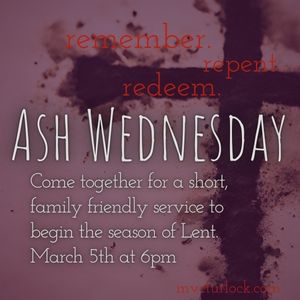
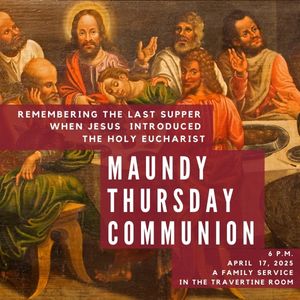
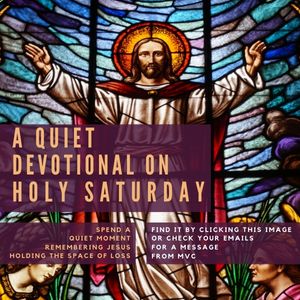
Lent To Remember
by Casey Giffen
Four-leaf clovers we?…no,
no fourfold
end-of-rainbow
selves to be known.
Remember that you are dust,
and unto dust you shall return.
We need luck?…no,
no wishful life;
separate not we:
a petal for body
a petal for soul
a petal for spirit
a petal for know
Remember that you are dust,
and unto dust you shall return.
That Tree transplanted,
rooted earthy soil;
each of us plants—
no not what we have—
who we are:
body, soul, spirit, know,
these grow as one…parts no.
Remember that you are dust,
and unto dust you shall return.
Lent counterintuitively lends
a plan: give up what we want.
Lent opportunistically lends
a hand: enter into new growth;
we flower and open up both/and.
Remember that you are dust,
and unto dust you shall return
not a generative that’s a must,
but a conduit to discern.
Holy Week marks the final week of lent where we remember the events leading to the death and resurrection of Jesus. Holy Week begins on Palm Sunday, as we remember the day Jesus rode into Jerusalem on a donkey to the shouts of the crowd. “Hosanna! Blessed is he who comes in the name of the Lord!” (Matthew 21:9) While some traditions celebrate every day of Holy Week, we at Monte Vista are going to focus on four main events. Along with our Palm Sunday service, we will remember Maundy Thursday, Good Friday, and Holy Saturday.
On Thursday, (Maundy Thursday) we will gather for a thirty minute communion service to remember the evening Jesus met with his disciples in the upper room for the Last Supper. On Friday, (Good Friday) we will gather in the courtyard to reflect on the sacrificial death of Jesus on the cross. Then, on Saturday, (Holy Saturday) you will receive a devotional via email to help you reflect on what must have felt like a hopeless day while Jesus remained in the tomb.
All of these special activities are family friendly. Our hope is that you will set aside time to engage with as many as possible so that we as a community of faith can prepare ourselves for the hope and joy of Easter morning. What a celebration that will be!
The Cross: The Word Became Flesh and Moved into the Neighborhood – Barbara Sartorious Bjelland
A Holy Week Reflection
Reflecting on this season of Lent, I have been fascinated with the giving up and the entering into aspects, even though the nefarious, atrocious events occurring worldwide affect me immensely. This season of Lent has allowed me not to turn toward my bellybutton, but to stomach how to love my neighbors, but in order to love others well, I must become like Jesus.
Intrigued at the end of Epiphany, I gave up carbohydrates for Lent and entered into a renewed reading of Henri Nouwen’s book Jesus A Gospel. I had purchased this gem at Yesterday’s Books on March 9, 2012, for $8.00 (I use the sales receipt as a bookmark). That year was my first experience interacting with Lent. Yet, it is the written illumination after the title page which allows the light of the Trinity to shine on this gem of a reading. It reads…The whole message of the Gospel is this: Become like Jesus.
To journey with Jesus during Lent is to become like Jesus, even when giving a lackluster attempt to give up and enter into. Perhaps like some of you, I, too, have experienced challenging times these past 40 days, namely within family relationships and relational interactions, albeit distant from daily hardships of domestic and international events. At times, I’ve wrestled with angry feelings, envious feelings, and sad feelings. By the Father’s grace, I’ve learned that those feelings do not define me. For instance, I am not an angry person, an envious person, or sad person to the degree whereby I’m defined as not enough, regardless of the depth of those extremely real emotions. Rather, I am beloved, just like Jesus’ identification when hearing the Father resurfacing during his baptism: This is my beloved son in whom I am well pleased.
Living out of grace repeatedly, this is how I desire to be like Jesus. Living out Imago Dei is the whole Gospel, for me, for you, for the world.
As I performed a visio divina—a prayer practice to pray and to allow the Trinity to speak—I was drawn to the severity of Jesus’ suffering in Barbara Sartorius Bjellland’s The Cross: The Word Became Flesh and Blood and Moved into the Neighborhood. Moreover, like Jesus interacting in the neighborhood, I am called to do the same as he did in my sphere of influence: non-violently, compassionately, mercifully, and justly. This is the kingdom “Servant zeitgeist” way that changes me, changes you, and changes the world, but it takes a humble heart, all of the counterintuitive interactions—comparison, rivalry, violence, war, destruction—that drove Jesus to the cross. As folks who call Monte Vista Chapel home, let’s live the whole Gospel: Become like Jesus…
INRI 1
by Casey Giffen
Some kill with kindness like a cocoa cup
filled brimly-marshmallowly to cheer up,
but nothing cools compassion like competition,
a Cain-Abel kind of killness disposition.
As brothers and sisters, sibling rivalries exist
birthing violence, still born injury we insist.
Mercy made its way on walkway palm branches
bearing love for humane infinite chances.
Compassion shared a Maundy upper room
by breaking bread and wine before the tomb.
Just like that, Hosannas died with brutality
as humanity perched Dove upon a broken tree.
Barabbas’ favoritism unleashed
the greatest injustice on the Dove of peace.
INRI Latinizes Christ,
as humans mull Servant zeitgeist 2 .
Living life with compassion and mercy,
non-violence, justice…that’s humanity
as we fall like grains of wheat to die
bearing much fruit like the Dove of life.
__
1 Iesus Nazarenus Rex Iudaeorum (Jesus of Nazareth, King of the Jews)
2 zeitgeist: the defining spirit or mood of a particular period of history as
shown by the ideas and beliefs of the time

HE IS RISEN!
Beginning on Easter Sunday, Eastertide (also known as Easter Season or Easter Time) moves us out of the fasting of Lent into the feasting of the resurrection! Comprised of the forty days between Jesus’ resurrection and his ascension into heaven, along with the following ten days that the early disciples waited for the coming of the Holy Spirit at Pentecost, Eastertide sets aside fifty full days to celebrate the most life-changing event in history!
During the Easter Season, we will focus on the post-resurrection appearances of Jesus as well as Jesus’ teaching about himself and his mission. The goal is to help us as a local church to embody Christ’s resurrection power and bring it to the ends of the earth. Let’s unpack that statement and make it as practical as possible.
As a church seeking to grow into Christ-likeness, we define spiritual formation as “our ongoing response to the grace of God, shaping us into the image of Christ, through the work of the Holy Spirit, in the community of believers, for the sake of the world.” To facilitate this inward-then-outward kingdom movement, I, along with the elders and staff, would like to invite you to a season of prayer. Specifically, prayer that God would use Monte Vista Chapel in new and fresh ways ‘for the sake of the world.’ That includes for the sake of our local body, for the sake of our community, for the sake of the greater church and for the sake of the unreached.
A practical way for you to personally engage in this Eastertide call to prayer is to reflect on how Jesus has made a difference in your life, then intentionally pray and watch for opportunities to share God’s love and radical hospitality with your church, your community, the greater body of Christ, and with the unreached. That’s exactly what Jesus commissioned us to do just before he ascended into heaven. “But you will receive power when the Holy Spirit comes on you; and you will be my witnesses in Jerusalem, and in all Judea and Samaria, and to the ends of the earth.” (Acts 1:8) So… let’s give away what God has so graciously given us. Let’s go and be his witnesses!
May it be so.
“Then Sings My Soul” by Brenda Stichter
Piano Man
Casey Giffen
He played music for all to hear
Along the streets a pleasant tune.
Soon people complained, began to jeer
Punishing Piano Man near high noon.
Then sings my soul with notes so glorious
Soaring on songbird wings victorious.
Weakened, he bowed his head underneath
Fallboard wires sharp as thorns slicing
Into him; he spiritedly bequeathed
And played the keys prior to dying.
Then sings my soul with notes so glorious
Soaring on songbird wings victorious.
Soon, soothing songbirds, like angels, saw
Sacrificial quaver notes floating high,
Heard lilted Light sounds, hopeful hoopla
Inviting them naturally to fly.
Then sings my soul with notes so glorious
Soaring on songbird wings victorious.
Forms of flying fowl gorgeously gathered:
Common, colorful birds filled the air.
Birds of prey flew to him who so mattered
And with the notes above answered prayer.
Then sings my soul with notes so glorious
Soaring on songbird wings victorious.
Bonded common cause and common claws
Birds gripped and lifted the piano grand,
Resurrected Paschal body awed
Creation honoring Piano Man.
Then sings my soul with notes so glorious
Soaring on songbird wings victorious.
His eye on sparrows, each you and me,
We sing Easter joy; we’re happy and free.
Brenda Stichter’s acrylic on canvas Then Sings My Soul represents numerous aspects of joy. Innovated with the cruciform structure of colorful musical staff and playfully painted piano keys, my imagination and appreciation for the season of Easter resurrects a rebirth of memories.
The first time I heard Keith Green perform Easter Song was 1978. He sang and played the piano at my church. His rolling-lilt combination of piano notes and his voice vocally presented the beauty of the resurrected Jesus. Far from “magical,” the joyous amalgamation of hope and healing reverberated within the Assembly of God sanctuary, bouncing off of the A-framed structured ceiling onto the orange shag carpet and long pews.
If interested, click the link to view a live performance of Easter Song by Keith Green. He explains and sings the beauty of Jesus. (Click here to watch) You will experience the same need and desire for us to cry out hallelujah with unabashed zeal, so refreshing to the soul, because as Green says, “…he (Jesus) wants to change your life.” That is what the resurrection of Jesus is all joyously about, a divinely transformed life. After watching the Keith Green video, I wonder about the word “world” in his refrain:
Joy to the world
He has risen, hallelujah
He’s risen, hallelujah
He’s risen, hallelujah, hallelujah
My creative imagination envisions and returns to Jesus’ triumphal entry. He’s interacting with humanity prior to Holy Week, prior to Good Friday, and prior to resurrection Sunday. He reminds the Pharisees that even if people keep quiet with their hosannas, the stones will cry out. Perhaps an expanded aspect of joy in Green’s lyrics “Joy to the world” is the unfathomable energy erupting when Jesus initially is resurrected. The world—Earth, God’s creation and its original design of everlasting shalom—exudes joy, and that supreme joy is not just for we humans to experience. Regardless of how much we hallelujahize Jesus, the ALL of the living, non-human world has waited an awfully long time to witness such joy, fulfillment. Perhaps, like humans, creation sometimes just cannot help itself. It explodes with natural hosannas because it knows the true source of joy…the Trinity.
This season of Easter which will end on June 8, for folks who call Monte Vista Chapel home, maybe we can organically convey to those outside the walls of MVC—whether or not these those folks worship the resurrected Jesus—that we desire to share what Keith Green shared: that the greatest healing is the healing of a sin-sick soul. In our desire of going out and making disciples—not converts—we can confess that we do not possess the power to perform that healing, but we do possess the conveyance of the resurrected healer for much needed restoration.
How we interact is the key. We listen first; we talk second. Listen to discern if the sin-sick-healing-heart storyteller has been granted eyes to see and ears to hear. Then, ask if the about-to-be-healed storyteller would like to hear your resurrection story, a transformational narrative worth telling because spirituality is best conveyed when we become deeply human with one another. With this approach, there are no others. Truly, not until all are healed will we be healed; not until all are whole will we be whole; and not until all are healthy will we be healthy. Simply too much joy exist because of Easter to keep it to us; like us, too many sin-sick souls exist—not simply because they are selfish or prideful—who are waiting, like creation, to reverberate the resurrection joy Then Sings My Soul…
In Acts 1:8, just before ascending into heaven, Jesus told his disciples, “But you will receive power when the Holy Spirit comes on you; and you will be my witnesses in Jerusalem, and in all Judea and Samaria, and to the ends of the earth.” In Acts 2, that promise was fulfilled as the Holy Spirit, amidst the sound of a rushing wind filling the room, descended upon the disciples. As they spoke, the gathered crowd was miraculously able to hear the gospel in their own language.
Historically, this incredible event is considered the launch of the church. Empowered by the Holy Spirit, the disciples and all who believed in Jesus are to continue his mission to establish God’s kingdom ‘on earth as it is in heaven.’ And while the season between Pentecost and Advent is known as ‘Ordinary Time’, there is really nothing ordinary about it. Rather, it is a time where we as the church focus on becoming the ‘sweet aroma’ of Christ to a world who desperately needs Jesus.
Therefore, as we turn the Church Calendar from The Story of Jesus to The Story of the People of God, we challenge you to consider where God is inviting you to continue the mission of Jesus. Where is God inviting you to embody the love, grace, truth, forgiveness, mercy, power, and presence of God’s kingdom? As each of us, empowered by the Holy Spirit, responds to this invitation, Jesus’ promise in Acts 1:8 will be fulfilled.
In order to encourage this missional focus, we have launched a sermon series through the book of Acts entitled “For the Sake of the World”. As we follow the early church’s journey, I am convinced their journey will inspire ours as we find practical ways to expand God’s Kingdom.
May it be so.
Ken
“The Spirit, Like Fire” Sarah M Hale
Keep track of what’s happening all year long at MVC!
Services, Activities, Prayer, Outreach and Fellowship oportunities for the whole family!
Meet The MVC Family
Are you curious to learn more about who we are at MVC? Perhaps you are curious about what a Sunday morning looks like. or have a question. Maybe you’re looking for an opportunity to meet some folks. Click the Button to learn more about what to expect, our staff and ways to get connected at MVC.
Weekly Newsletter
There is always a lot going on at MVC so to keep you informed we send out a weekly newsletter. Click the button below to view the most current issue showing classes, opportunities to serve, our current series and more! you can SUBSCRIBE HERE to have it sent directly to you via email. There is a place for you!
